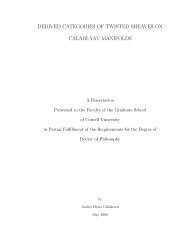Shimura lifts of half-integral weight modular forms - Department of ...
Shimura lifts of half-integral weight modular forms - Department of ...
Shimura lifts of half-integral weight modular forms - Department of ...
You also want an ePaper? Increase the reach of your titles
YUMPU automatically turns print PDFs into web optimized ePapers that Google loves.
10 DAVID HANSEN AND YUSRA NAQVI<br />
Let δ ′ = gcd(c, δ). We have that there exists an integer y such that (δ/δ ′ )|(cy + d), and so<br />
we get<br />
<br />
<br />
f(δz)<br />
k<br />
<br />
a b<br />
c d<br />
= δ −k/2 <br />
<br />
f(z)<br />
Inserting this into the definition <strong>of</strong> g(z) gives<br />
<br />
<br />
g(z)<br />
2k<br />
<br />
a b<br />
=<br />
c d<br />
=<br />
<br />
δ|r<br />
gcd(δ,r/δ)=1<br />
<br />
δ|r<br />
gcd(δ,r/δ)=1<br />
<br />
aδ/δ ′ δ<br />
<br />
k<br />
′ (ay + b)<br />
c/δ ′ δ ′ (cy + d)/δ<br />
= (δ/δ ′ ) −k <br />
δ ′2z − δ ′ y<br />
f<br />
<br />
<br />
χδ(−1)f(δz)f(rz/δ)<br />
δ<br />
2k<br />
<br />
.<br />
<br />
a b<br />
c d<br />
<br />
δ<br />
−k r/δ<br />
−k χδ(−1)<br />
f<br />
(δ, c) (r/δ, c)<br />
<br />
δ ′ −y<br />
0 δ/δ ′<br />
<br />
δ ′2 z − y ′<br />
δ<br />
<br />
f<br />
δ ′′2 z − y ′′<br />
where δ ′ is as before, δ ′′ = (r/δ, c) and y ′ and y ′′ are integers that depend on δ. This<br />
trans<strong>forms</strong> into<br />
(3.17) gγ(z) = <br />
δ|r<br />
gcd(δ,r/δ)=1<br />
<br />
r<br />
−k χδ(−1) f<br />
(r, c)<br />
δ ′2 z − y ′<br />
δ<br />
<br />
f<br />
δ ′′2 z − y ′′<br />
We now consider<br />
(3.18)<br />
<br />
a<br />
g(2z) <br />
2k c<br />
<br />
b<br />
= 2<br />
d<br />
−k <br />
2<br />
g(z) <br />
2k 0<br />
<br />
0 a<br />
1 c<br />
<br />
b<br />
,<br />
d<br />
<br />
which gives us that g(2z) |2k<br />
a b<br />
c d = gγ(2z) if c is even or gγ((z − x)/2) if c is odd, where<br />
x is some integer that depends on d. This yields<br />
<br />
<br />
h(z)<br />
2k<br />
<br />
a b<br />
= gγ(z) − 2<br />
c d<br />
k−1 gγ(2z) or<br />
= gγ(z) − 2 −k−1 gγ((z − x)/2).<br />
Thus, in all cases, the constant term <strong>of</strong> the Fourier expansion is a constant multiple <strong>of</strong><br />
( r<br />
(r,c) )−k a(0) 2 χδ(−1), and hence this term vanishes if and only if f is a cusp form or<br />
(3.19)<br />
<br />
δ|r<br />
gcd(δ,r/δ)=1<br />
χδ(−1) = 0.<br />
In particular, this sum vanishes if and only if χr decomposes into a product <strong>of</strong> Dirichlet<br />
characters to prime power moduli which are not all even. Note that by [7], this is equivalent<br />
to θ(χr; z) being a cusp form. This same method can be applied to <strong>modular</strong> <strong>forms</strong> <strong>of</strong> higher<br />
level; however, the computations are more complicated.<br />
δ<br />
<br />
.<br />
δ<br />
<br />
,
















